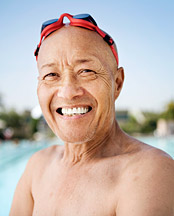Enjoying the Golden Years: Staying Fit for Life
By Perry Nickelston, DC
Ah, the Golden Years; that long-awaited time to sit back, relax and enjoy the rest of your life after decades of hard work. Not so fast - it's also the time during which the natural aging process can wreak havoc on your body. Why? Muscle mass decreases as people age; beginning in the fourth decade of life, adults lose 3-5 percent of muscle mass per decade, and the decline increases to 1-2 percent
per year after age 50.
Anti-aging metabolic hormones such as growth hormone and testosterone also plummet as we age. These hormones are responsible for building lean muscle and preventing tissue breakdown. Fortunately, we can do something about it: These hormones are primarily increased with regular physical activity.
 It's the old adage, "Use it or lose it!" Exercise is of vital importance for older adults. It keeps you strong, helps burn calories and maintain weight, improves flexibility, and contributes to balance and bone strength. What are the best types of exercise? A regimen that builds lean muscle and promotes endurance, flexibility and stability is the goal. Here are six of the most effective exercise options to accomplish this with minimal risk of injury. It is highly recommended that you consult your doctor for a complete physical evaluation prior to starting any new exercise routine.
It's the old adage, "Use it or lose it!" Exercise is of vital importance for older adults. It keeps you strong, helps burn calories and maintain weight, improves flexibility, and contributes to balance and bone strength. What are the best types of exercise? A regimen that builds lean muscle and promotes endurance, flexibility and stability is the goal. Here are six of the most effective exercise options to accomplish this with minimal risk of injury. It is highly recommended that you consult your doctor for a complete physical evaluation prior to starting any new exercise routine.
1. Brisk Walking
Walking is a great low-impact form of cardiovascular activity. It improves endurance and lean muscle tone in your legs. The key is to avoid walking too slow; maintain a brisk pace with long strides and arm swings. Adding ankle or wrist weights to enhance aerobic calorie-burning helps send more oxygen to your heart, increasing endurance. Even low- to moderate-intensity walking can have both short- and long-term health benefits.
 How fast is brisk? Determine your target training heart rate and maintain this pace for at least 30 to 60 minutes, three to four days per week. (For example, a good target heart rate for a 60-64-year-old is 96-120 beats per minute. For more information on target training heart rates by age, read "Find Your Fat-Burning, Muscle-Building Zone" in this issue.) A variety of heart rate watches are available to help track your target heart rate during exercise. Try changing your terrain by walking up hills and stairs for added resistance and difficulty. Better yet, throw on some hiking boots and hit the open wilderness trails and commune with Mother Nature. Just remember not to push too hard or put yourself in a position to fall or otherwise injure yourself.
How fast is brisk? Determine your target training heart rate and maintain this pace for at least 30 to 60 minutes, three to four days per week. (For example, a good target heart rate for a 60-64-year-old is 96-120 beats per minute. For more information on target training heart rates by age, read "Find Your Fat-Burning, Muscle-Building Zone" in this issue.) A variety of heart rate watches are available to help track your target heart rate during exercise. Try changing your terrain by walking up hills and stairs for added resistance and difficulty. Better yet, throw on some hiking boots and hit the open wilderness trails and commune with Mother Nature. Just remember not to push too hard or put yourself in a position to fall or otherwise injure yourself.
2. Resistance Training
Don't worry, you won't end up looking like Arnold Schwarzenegger by doing a little resistance exercise, and it's important to maintain your existing muscle tone as you age; the most effective way is via strength training. However, instead of using your typical weights and gym equipment, try working out with rubber tubes and bands instead. These give you added resistance in two directions, making for a more effective workout and much less chance of injury to your joints, ligaments and tendons. There is no need to lift heavy weights to burn calories and increase strength. Just 20 minutes three to four times per week with bands or tubes can make significant changes in how your body looks and feels. Optimum results are obtained with fast-paced, full-body routines. Again, remember to start slow and talk to your doctor before beginning any new exercise regimen.

